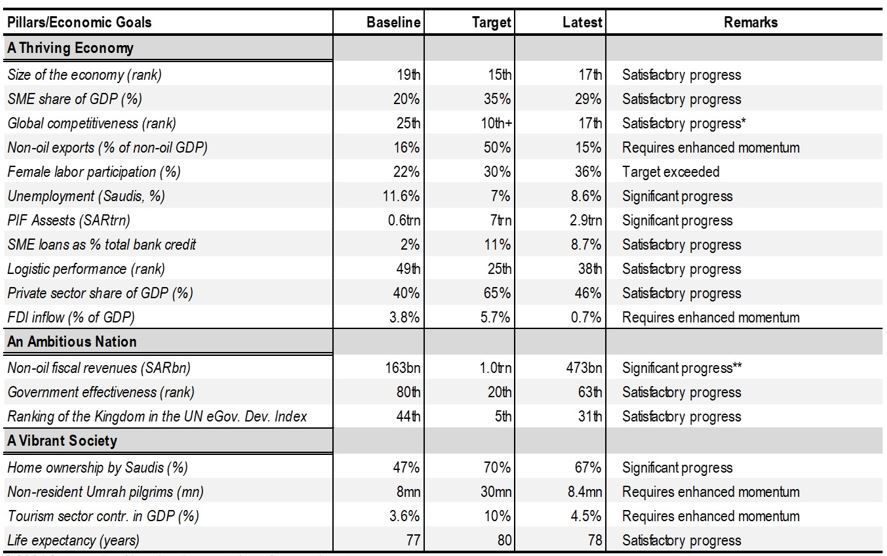
A recent report by Citi Research’s Ilker Domac explores Saudi Arabia's Vision 2030 reform agenda, assessing progress made at the program’s halfway point and examining the potential macroeconomic effects of continuing structural reform.
Vision 2030 aims to diversify the Kingdom’s economy historically oil dependent economy and boost growth through a raft of structural reforms.
The Citi Research report points out that Saudi Arabia’s need to step up efforts at economic diversification has become even greater as the world has accelerated toward economies that are less carbon-intensive.
Declining demand for fossil fuels might permanently lower the value of Saudi Arabia’s non-renewable natural capital. As a consequence, the future performance of its economy will largely depend on how policymakers diversify their portfolio—with potential diversification steps including investing in human capital, building Saudi Arabia’s stock of productive assets and boosting the value of renewable natural capital.
The vehicle for addressing these challenges is Vision 2030, launched in 2016 and so at its halfway point. As the authors note, Vision 2030’s core mission is to reduce oil dependence, diversify income sources and bolster competitiveness.
A key driver of the agenda is the Public Investment Fund (PIF), Saudi Arabia’s sovereign wealth fund, with total estimated assets of $777 billion. This fund is also the main entity for implementing the National Investment Strategy (NIS), launched in 2021.
The NIS’s three strategic objectives for Saudi Arabia are to build national industrial resilience, become an integrated regional manufacturing hub, and expand global leadership in selected segments.
The report says that Vision 2030 has attracted substantial attention from global investors. Given this level of interest, the report offers an assessment of Vision 2030’s progress and challenges, an analysis of gaps in structural reform, and an assessment of the macro effects of such reforms to provide guidance for how to prioritize, bundle and sequence the measures seen as part of the agenda.
Progress and challenges
In looking at 18 goals, the report’s authors conclude that Saudi Arabia has made significant progress or exceeded its target in five, made satisfactory progress in nine, and needs “enhanced momentum” to achieve four.
Selected Vision 2030 Objectives: Actuals vs. Targets

© 2024 Citigroup Inc. No redistribution without Citigroup’s written permission.Baseline is as of 2016. *Since the WEF is discontinued, we use the IMD World Competitiveness Yearbook. **As of 3Q 2023 (four-quarter rolling sum)Source: Citi Research, Haver Analytics, IMF, Saudi Vision 2030, Knight Frank
Areas of significant progress identified by the Citi Research team include female labor-force participation, which has surpassed its 2030 target of 30%; a significant expansion of home ownership from 47% to 67% in 2022; non-oil fiscal revenue reaching 2.5 times its baseline by 2022; and the transformation of the PIF from a relatively low-profile sovereign wealth fund into an assertive international dealmaker and manager of megaprojects.
Reform gaps and the path forward
The report looks at Saudi Arabia’s performance in eight key areas—governance, business regulation, external sector, labor market, credit market, education, health and environment—in comparison with the average OECD country.
It also asks what the impact on growth would be if structural gaps were narrowed. Structural reforms, they noted, can bolster economic growth through various channels. The authors’ estimates suggest raising Saudi Arabia’s governance score to the OECD average could lead to a cumulative increase of 19% in real GDP after six years, while comparable external-sector reforms could increase growth by 5%. Improving the business and credit environment could raise output by about 3%, with a 1.5% gain from labor-market reforms.
Strengthening governance, the report argues, will be pivotal for a sustainable economic diversification driven by the private sector, enabling new investments and jobs and also magnifying the payoff from reforms elsewhere.
To access the full report, if you are a Citi Velocity subscriber, please click here Saudi Arabia Multi-Asset - Macro-to-Micro: From Vision to Reality: The Transformative Potential of 2030 Agenda (28 Jan 2024)
Citi Global Insights (CGI) is Citi’s premier non-independent thought leadership curation. It is not investment research; however, it may contain thematic content previously expressed in an Independent Research report. For the full CGI disclosure, click here.